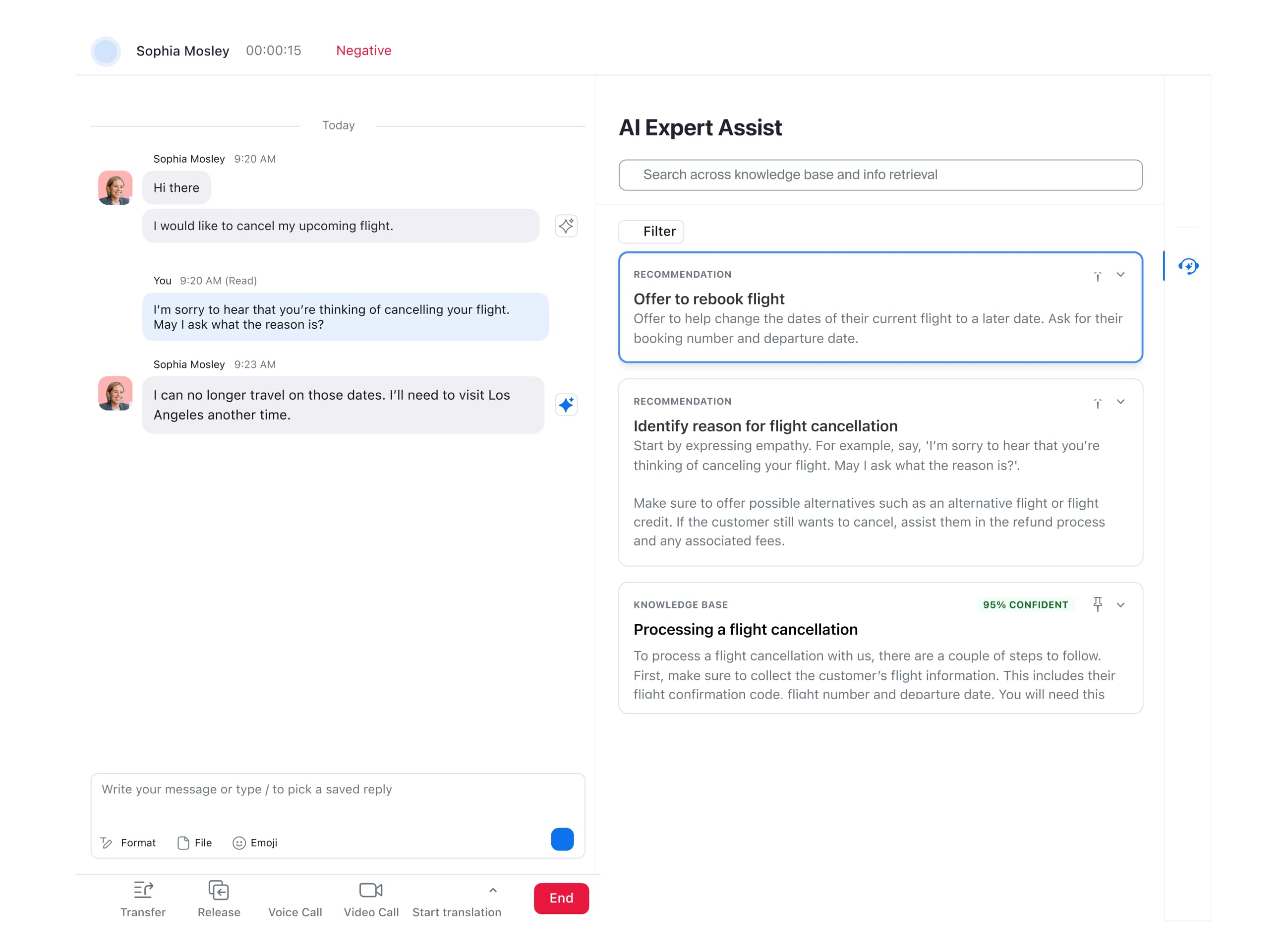
In conversation with Adrian Swinscoe: Is your contact center ready for the future of customer experience?
Join us for insights on contact center innovation from Adrian Swinscoe, focusing on AI's role in revolutionizing customer experience.
5 steps to contact center AI implementation your customers will thank you for.
Updated on October 14, 2024
Published on September 30, 2024


Our recent research report with Morning Consult unveiled some core insights about rising customer expectations in the age of GenAI. It’s no surprise that customer experience is faltering as consumer expectations rise (the report found that 63% of consumers will leave a brand after one or two negative interactions vs. 59% in 2022). The learnings we uncovered are supported by other research bodies, such as Forrester’s US Customer Experience Rankings 2024, which illustrates how customer service quality is at an all-time low.
The report examined how these perceptions differ between generations and how sentiment toward AI in the customer experience might impact these perceptions. Surprisingly, GenX is the hastiest to switch to a competitor after one or two negative experiences (65%) vs. GenZ (58%). GenZ and Millenials also have more positive sentiments around AI’s benefits, but once educated, Boomers are significantly more open to AI in the customer experience.
The results showed that it’s never been more important to take a customer-led approach in your contact center, and the same goes for your approach to AI for CX implementation. As Deloitte identified in its 2024 Global Contact Center Survey, improving efficiency with AI is just as important as improving customer service.
This guide will dive into the topic of contact center AI and summarize the five key takeaways of our research. We’ll share five actionable, customer-led steps you can take in your contact center today to combat the doom and gloom the data illustrates with the help of AI for CX. If you haven’t already done so, we recommend checking out the full research report.
Discover how consumer expectations are growing and how they differ between generations in a new world of AI.
First things first, what do we mean by contact center AI? Contact center AI, or artificial intelligence, is designed to enhance customer, agent, and supervisor experience, and is revolutionizing how businesses build better brand experiences at every touch point. Unlike traditional systems, which rely on basic automation or siloed tools, contact center AI—when fully integrated—creates a seamless, intuitive experience for customers, agents, and supervisors. It doesn’t just handle routine tasks; it anticipates customer needs and supports agents with real-time insights to help continuously improve performance.
Here at Zoom, we believe contact center AI isn’t about replacing humans with robots. Instead, AI can help humanize self-service experiences, provide real-time coaching guidance for every agent, reduce redundant administrative work, and proactively alert supervisors when help is needed. By focusing on humanizing interactions, Zoom Contact Center’s AI capabilities help customers feel understood and valued, while agents are empowered to deliver the kind of service customers expect. This unified, AI-focused approach transforms the contact center into a proactive, connected hub that enhances customer relationships and operational efficiency in ways traditional systems simply can’t.
Through the research report we commissioned with Morning Consult, we have identified five key takeaways that can help you formulate an effective contact center AI strategy that better serves your customers.
With diminishing expectations, there’s a sense of urgency for CX leaders to get on board to harness the power of AI in the right ways and educate their customers. By partnering with a reliable and innovative provider such as Zoom, you can get your contact center on the right track to delivering the kind of service consumers of all ages seek.
Here are some next steps you can take to implement AI for CX to help your agents deliver the fast and frictionless service your customers expect.
Many businesses are still using traditional, outdated chatbots despite the arrival of GenAI and more advanced conversational AI solutions. These more basic models often lack the ability to handle more complex, multi-faceted customer inquiries and can’t respond in a conversational, human-like tone. Consumers can see the potential for chatbots to deliver faster results and shorter wait times, but those who have used chatbots in the last year are rarely satisfied with the resolution.
Improving your chatbot with a new breed of conversational AI could be a pivotal way to solve consumers’ main pain points of long wait times and slow resolutions.
Take Zoom Virtual Agent, for example. Zoom Virtual Agent, part of the Zoom Customer Experience suite of products, is an advanced conversational AI solution built for the next-generation contact center. Administrators can use Zoom Virtual Agent’s auto-bot flow generation feature to create flows that meet a customer’s needs. By auto-generating a list of intents from one prompt, it can quickly solve simple queries 24/7, while providing a path to an agent when required.

According to the research, many consumers are not fully aware of all of the benefits AI can bring to the customer experience, such as personalization. Around-the-clock service or 24/7 availability is more tangible for consumers and can be seen in action via chatbot solutions, a primary touchpoint in the customer experience.
The ability to self-serve is crucial for younger generations, who are more likely to work during the day and don’t have time to contact customer service during regular business hours. Chatbots are essential in the experience and are front and center in customers’ minds when it comes to AI. But with recent developments in GenAI, you can also use automation to delight at other touch points when serving your customers.
What if you could predict the issue a customer is calling about before they connect? How about adding a custom welcome message based on their previous interaction or purchase? For example, if you’re a ticket vendor, you could add a personalized message according to a customer’s last purchase: “I hope you enjoyed the baseball game last week!”
With AI Companion for Zoom Contact Center,* our proprietary generative AI assistant, there’s the potential to speed up and personalize your customer interactions. Agents can automatically receive call summaries and meeting notes, relieving the post-call burden of note-taking and providing quick context for the next agent. AI Companion for Zoom Contact Center also powers Zoom AI Expert Assist, which analyzes conversations on the spot and serves up the right information at the right time to help agents when they get those complex queries. Each of these features results in faster call resolution, less customer frustration, and the opportunity for agents to add a personal touch to their engagements.

Mindlessly rolling out AI is a bad idea. While developing your contact center AI strategy, consider where you can also educate your customers on the benefits.
As live phone support and live messaging are the most preferred methods of support, let’s start there with a few examples:
Another option is to create a customer content campaign on the topic of “How we use AI to serve you better.”
However you decide to educate your customers, making it easy for them to escalate to a human agent when required is vital.
As consumers become more interested in using other channels for customer service interactions, the need for an omnichannel experience becomes more pressing. Whereas many companies offer multiple channels, they are not always connected, which leaves agents unable to get a full view of the customer’s issue. An omnichannel solution like Zoom Contact Center allows agents and supervisors to see all of a customer’s interactions in one pane of glass, including phone, video, SMS, email, chat, WhatsApp, and Meta Messenger.
AI also helps in an omnichannel view by pulling a case summary together from various channels, making your agents’ lives easier and helping your customers feel relieved to have their issues resolved more efficiently.
On a final note, our research clearly shows that consumers still value and appreciate human involvement in customer experience. This indicates that a balanced approach to AI implementation is wise for AI to be successful. AI is best used to enhance, not eliminate, the human touch. A recommended first step here is to bring some of your agents and supervisors into the mix when planning your contact center AI strategy to gain perspective and find the right combination of automation and live agent involvement in your customer experience.
Our guide, Getting started with AI in the contact center, provides more insights and practical tips on this approach.
Wherever you are on your contact center AI journey, we hope these key takeaways and next steps for a customer-led approach to AI implementation were helpful.
Join us at Zoomtopia 2024 on October 9, where we’ll have dedicated CX sessions showcasing our innovations and how a customer and agent-led AI strategy can improve your customer experience.
At Zoom, we’re in the business of delivering happiness. We’d love to chat with you about how Zoom Contact Center and its AI features can benefit your business. Book a demo today to speak to one of our CX experts.